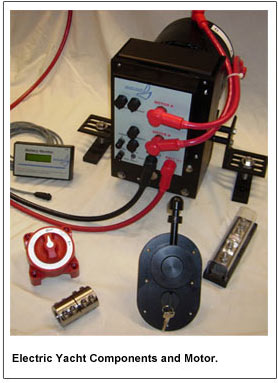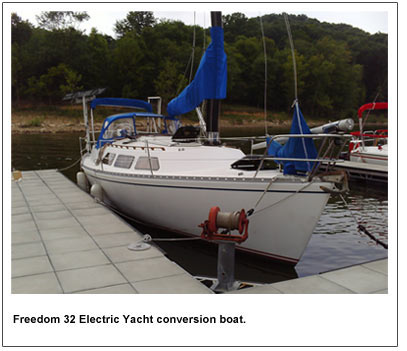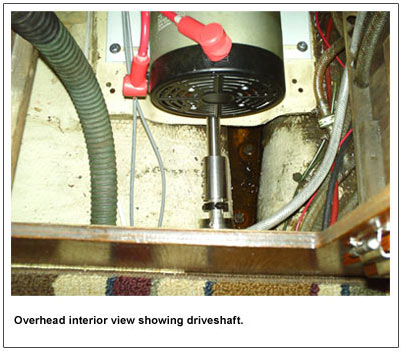|
Electric Yacht: Clean, Green, Quiet.
Product Review by Tony Green
 What sailboat system generates
more foul language than any
other? Engines, right? Marine heads
are second and electronics come in
third, especially when owners throw
the manuals away without reading
them.
What sailboat system generates
more foul language than any
other? Engines, right? Marine heads
are second and electronics come in
third, especially when owners throw
the manuals away without reading
them.
As much as we rely on our auxiliary
engines, many of us hate them
with a passion. The vast majority of
sailboat engines are internal combustion
outboards or inboard diesels,
with a few inboard gas motors still
around. What’s not to love? They can
be hard to start and require a warm-up
period, they are sometimes temperamental
and stall at low speeds (usually
when you need them most), both
the fuel and exhaust are smelly and
dangerous, the cooling systems can
clog, maintenance and winterizing
are not trivial and worst of all in the
21st century, they are powered by (gasp)
fossil fuels.
For decades, our paradigm has
demanded internal combustion engines to
meet our needs on the road and on the
water. Electric Yacht of Golden Valley,
Minnesota, is out to change that way of
thinking. The company’s electric propulsion
systems offer a clean, green and quiet
alternative to traditional sailboat auxiliaries
for a large number of sailors.
Chances are you’re one of them.
Electric Yacht was founded in 2007
by Scott McMillan, an electrical engineer
and sailor who began tinkering with
electric motors on his own boats. The
company’s target market is the increasing
number of sailboats with aging inboard
engines that are
in need of overhaul or
replacement. Within
that market are large
subsets of lake sailors,
racers, weekenders
and coastal cruisers
for whom a big diesel
is serious overkill.
Electric propulsion
offers a simpler and
more enjoyable option
for the many boat
owners who only
use their engines for
short distances to get
in and out of the slip,
ramp, mooring or
anchorage.
The company’s electric motors
mount to existing engine rails and
propeller shafts. Multiple reduction
ratio options accommodate different
boat and propeller sizes and installation
can easily be done with the boat
in the water. Wiring connections are
simple, with pre-fabricated cables
provided to connect batteries, motor,
throttle quadrant and battery monitor.
An average conversion from
inboard diesel to electric is weight
and cost neutral compared with an
engine rebuild, space is usually
gained and your bilge will never
smell like fuel again. List prices vary
from $3,695 for a Model 100ib (48
VDC, 5 HP) to $5,495 for a Model
260ib (12HP @ 48VDC, 18HP @
72VDC). Horsepower ratings
between electric and internal combustion
are not directly comparable,
since electric motors do not have power
siphoned off for engine-driven auxiliaries
such as cooling pumps, fuel pump, alternator,
etc. Typically, an electric system
can replace a diesel or gas engine of twice
the horsepower without a significant loss
in top speed.
 In addition to the Electric Yacht system,
you will need batteries and a charger.
The cost of eight flooded lead-acid batteries
and a charger is about $1,500, while
more advanced AGM batteries with
charger are closer to $2,500. The motor
and controller are basically maintenance free,
although battery management and
upkeep still apply. If AGM or lithium batteries
are used, this can be reduced significantly.
The company has more than 40
installations worldwide and can power
sailboats up to 40 feet long.
In addition to the Electric Yacht system,
you will need batteries and a charger.
The cost of eight flooded lead-acid batteries
and a charger is about $1,500, while
more advanced AGM batteries with
charger are closer to $2,500. The motor
and controller are basically maintenance free,
although battery management and
upkeep still apply. If AGM or lithium batteries
are used, this can be reduced significantly.
The company has more than 40
installations worldwide and can power
sailboats up to 40 feet long.
Electric propulsion’s critics normally
focus on two limitations: lack of
power and range. Sure these systems are
nifty, but can they punch through high
winds, waves or currents and can they
really drive the boat for more than a few
hours? As I would learn, power is not a
problem for Electric Yacht. But range is
limited and there’s just no getting
around the fact that battery technology,
while improving, is the weak link.
Traditional lead-acid batteries are the
most affordable and are widely available.
Lithium batteries are lighter and
have increased life and range, but cost
more. The company is optimistic that
industry investments in hybrid and electric
automobiles will provide much
needed advancement in electrical storage
for the boating market. These
improvements will only increase the size
of Electric Yacht’s target market, and
most boaters should still be satisfied
with today’s technology.
 Recharging the batteries is obviously
important and options are numerous.
For a boat in a marina slip, a traditional
shore power charger is normally used.
Boats at anchor or on a mooring typically
use solar panels, wind generators
or a combination of the two. To extend
range indefinitely, owners can carry a
portable gas generator or install a small
diesel generator onboard, although
purists might suggest that this is heading
in the wrong direction. The Electric
Yacht systems can also regenerate
power to help charge the batteries. The
boat’s motion under sail spins the propeller
and shaft, turning the electric
motor into a generator and putting current
back into the batteries.
Recharging the batteries is obviously
important and options are numerous.
For a boat in a marina slip, a traditional
shore power charger is normally used.
Boats at anchor or on a mooring typically
use solar panels, wind generators
or a combination of the two. To extend
range indefinitely, owners can carry a
portable gas generator or install a small
diesel generator onboard, although
purists might suggest that this is heading
in the wrong direction. The Electric
Yacht systems can also regenerate
power to help charge the batteries. The
boat’s motion under sail spins the propeller
and shaft, turning the electric
motor into a generator and putting current
back into the batteries.
I met Scott McMillan, company
President and Chief Engineer, and
Bill Tomlinson, Director of Marketing,
for a test sail on Lake Koronis in central
Minnesota. This 3,000-acre, five-mile long
lake is the perfect application for
this technology. Scott’s Catalina 27 is
kept on a mooring and the motor is used
to get on and off the buoy and for sunset
cruises and quiet puttering around the
lake. The boat normally sits all week
while a wind generator recharges the
batteries and is more than ready for the
next weekend. That use pattern
describes a lot of sailboats out there,
mine included.
There would be no puttering for our
test run. The lake was whipped up by 15-
knot winds with gusts over 20. We were
shivering in the cold October rain and
northeast wind, but I was secretly pleased
to see how Electric Yacht’s equipment
performed in a healthy breeze and chop.
Scott got us underway with a turn of the
key. There was no warm-up required and
full power was instantly available, even at
low speeds. A low hum let me know that
the motor was on, and the tone changed
with RPM, giving good feedback that the
controller was responding. While not
silent, it was much quieter than a diesel,
and we easily carried on a conversation
inside the cabin with the motor running.
The Catalina effortlessly plowed through
the building waves and hit hull speed with
plenty of reserve. So much for the concern
about being underpowered. Battery
condition and discharge rate were visible
at a glance and the cockpit monitor displayed
amps and time left on the battery.
At high speed the readout said we had 2.5
hours left, plenty of time to get off the
five-mile lake in a hurry if we needed to.
Backing off the throttle increased our
time remaining and the monitor was
instantly updated. Motoring at a couple of
knots in a dead calm provides more than
eight hours of run time on a full charge.
When it was my turn to drive, I put the
motor through its paces and Scott even let
me dock his boat in the wind and waves
to test maneuverability. The single-lever
quadrant was similar to operating an
inboard auxiliary, without the fear that the
motor would stall if idled down in gear, as
internal combustion engines can do.
I came away convinced that this
technology is well designed, affordable,
easy to install and more than capable to
meet many sailors’ needs. Evaluating
these systems requires an honest analysis
of what type of sailing you really do.
Long-distance voyagers will probably
stick with fossil fuels, since they pack
more power per pound than batteries. In
my opinion, electric propulsion should be
considered by the high number of sailors
who day sail, race, weekend or coastal
cruise within a few miles of shore and just
don’t run their engines that much. The
benefits are many. Instant on with no
warm-up time. No more trips to the fuel
dock. No oily bilges or fuel and exhaust
fumes in the cabin and cockpit. Peaceful
motor-sailing. Clean. Green. Quiet. Isn’t
that what sailing is all about anyway?
More information, including specifications,
pricing and customer testimonials
are available on the company’s website
at www.electricyacht.com
Tony Green has been boating since
1985, including eight years on U.S. Navy
nuclear submarines. He currently teaches
for Northern Breezes Sailing School and
sails with his wife and two daughters on
Lake Calhoun in Minneapolis, on the St.
Croix River and on Lake Superior.
TOP
|